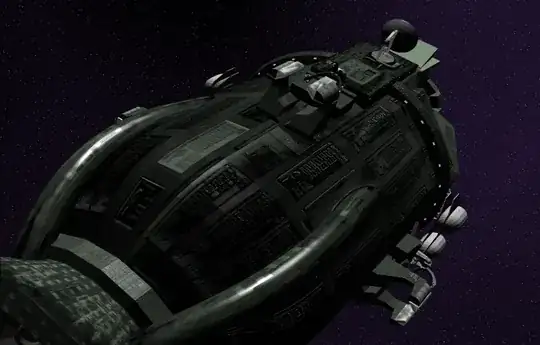ksbes answered the core part of the question, but I'd like to reframe it slightly to show how terrible the idea is.
Your tugs, mass $m_t$ need to push a barge, mass $m_b$ up to .1c, and decelerate a second barge down from .1c. They also need to reverse their velocity vector in between, slowing down their own mass to a velocity of 0 relative to their starting point and then back up to .1c again. If the tug did the trip on its own, it would need a $\Delta_v$ of 0.4c. Generally speaking, you don't want a $\Delta_v$ greatly in excess of your rocket's exhaust velocity, and the only thing with an exhaust velocity that high is a beam core antimatter rocket (we'll ignore the implausibility of such a rocket for now) with a $v_e$ of about 0.33c.
Working backwards, the braking $\Delta_v$ will be 0.1c, with a mass of $m_t + m_b$.
Now, A gentleman named Robert Frisbee did an interesting paper on beam-core driven starships (How to build an antimatter rocket for interstellar missions) where he observes that the normal delta-V equations don't apply to antimatter rockets, because a load of the mass involve simply up and vanishes (or rather, turns into deadly gamma rays, but one problem at a time). Instead you have to use a different equation to compute the mass ratio of your ship:
$$k_1 = \sqrt{(1-a)^2 + 4av_e^2 / c^2}$$
$$k_2 = (-2v_e*\Delta_v/c^2) + 1-a$$
$$R = \left(\frac{(k_2-k_1)(1-a+k_1)}{(k_2 + k_1)(1-a-k_1)}\right)^{\frac{1}{k_1}}$$
where $a$ is the proportion of mass flying out of the back of your rocket compared to that going into the reaction chamber... Frisbee's antimatter rocket had $a=0.22$. Anyway, this gives a mass ratio the boost and brake phases of 2.55 (eg. the fuel mass is 2.55 times the dry mass of the tug and barge). The non-beam-core mass ratio equation would give more like 1.35, so you can see already that things are starting to get awkward.
The braking phase needs a propellant mass of $m_{p3} = 1.55(m_t + m_b)$. The turnaround phase needs a $\Delta_v$ of 0.2c, and so a mass-ratio of 4.44. It needs to push the propellant used for the braking phase too, giving a a propellant mass of $m_{p2} = 3.44(m_t + m_{p3})$. The boost phase needs a $\Delta_v$ of 0.1c, and it needs to push the barge and the rest of its fuel, giving a propellant mass of $m_{p1} = 1.55(m_t + m_b + m_{p2})$. This gives a required initial mass ratio of $16.1466m_t + 10.8146m_b$. Lets say the tug is 100 times smaller than the barge. This means that for every tonne the barge weighs, you need nearly five and a half tonnes of pure antimatter. And that's not even per tonne of cargo, because there's the hull of the barge, the shielding, the navigation, the manoevering and docking systems and all the rest! Oh, and building a ship with a mass ratio that high is an additional tricky engineering task, especially when you're talking about antimatter confinement!
This is worse than simply strapping a suitable antimatter rocket to the barge and letting it boost and brake itself, because you're wasting fuel on your tug. The $\Delta_v$ for the barge alone would be just 0.2c, and with a mass ratio of 4.44 you'd need only about 1.72 tonnes of antimatter per tonne of barge!
If you used a single antimatter rocket to do the boosting, and a combination of magnetic parachute, solar sail, sail beam or other non-rocket-based braking system, you immediately reduce your propellant cost-per-launch to a little over a three quarters of a tonne of antimatter per tonne of barge, plus whatever the power requirements of the braking system are (which can be done with solar or fusion, as seems appropriate, which will be cheaper, simpler and safer). Hell, maybe now you can use your beam for the boost phase too, and avoid the whole dangerous business of mucking about with antimatter.
Now there's no tug, there's no need for human crews to spend months and months in a tiny tin box at dangerous speeds strapped to many, many tonnes of a hideously unstable propellant where any one of a thousand little problems will vapourise them in an instant. No maintenance of tugs. No need for rescue operations to retrieve the crew if anything goes wrong (you were gonna do that, right?).
Over seven times cheaper per launch (or more, if you have a beam launch), vastly safer, no miserable crew. What's not to like? And even if you don't like it, you risk someone else setting up this cheap safe alternative in your place, and then where will you be?

